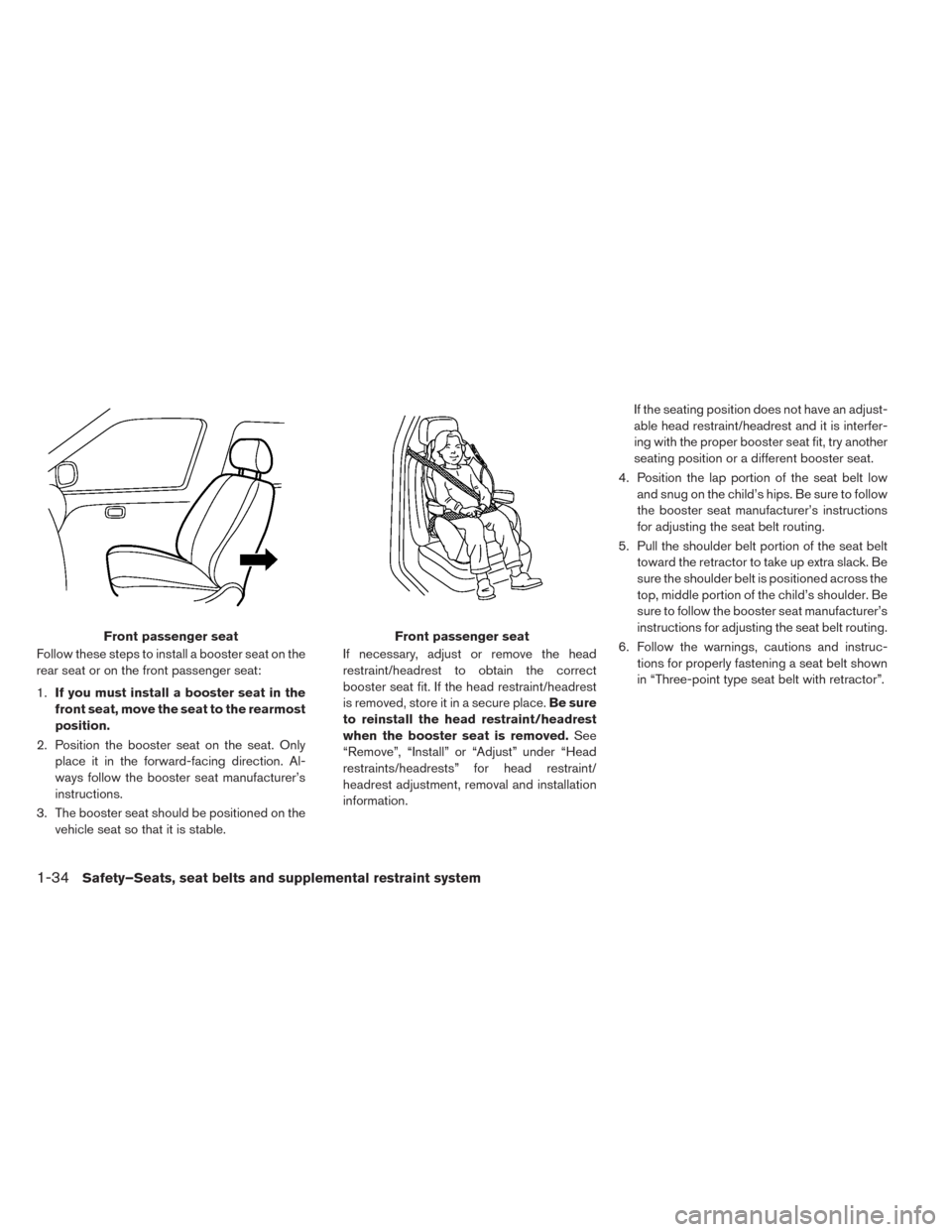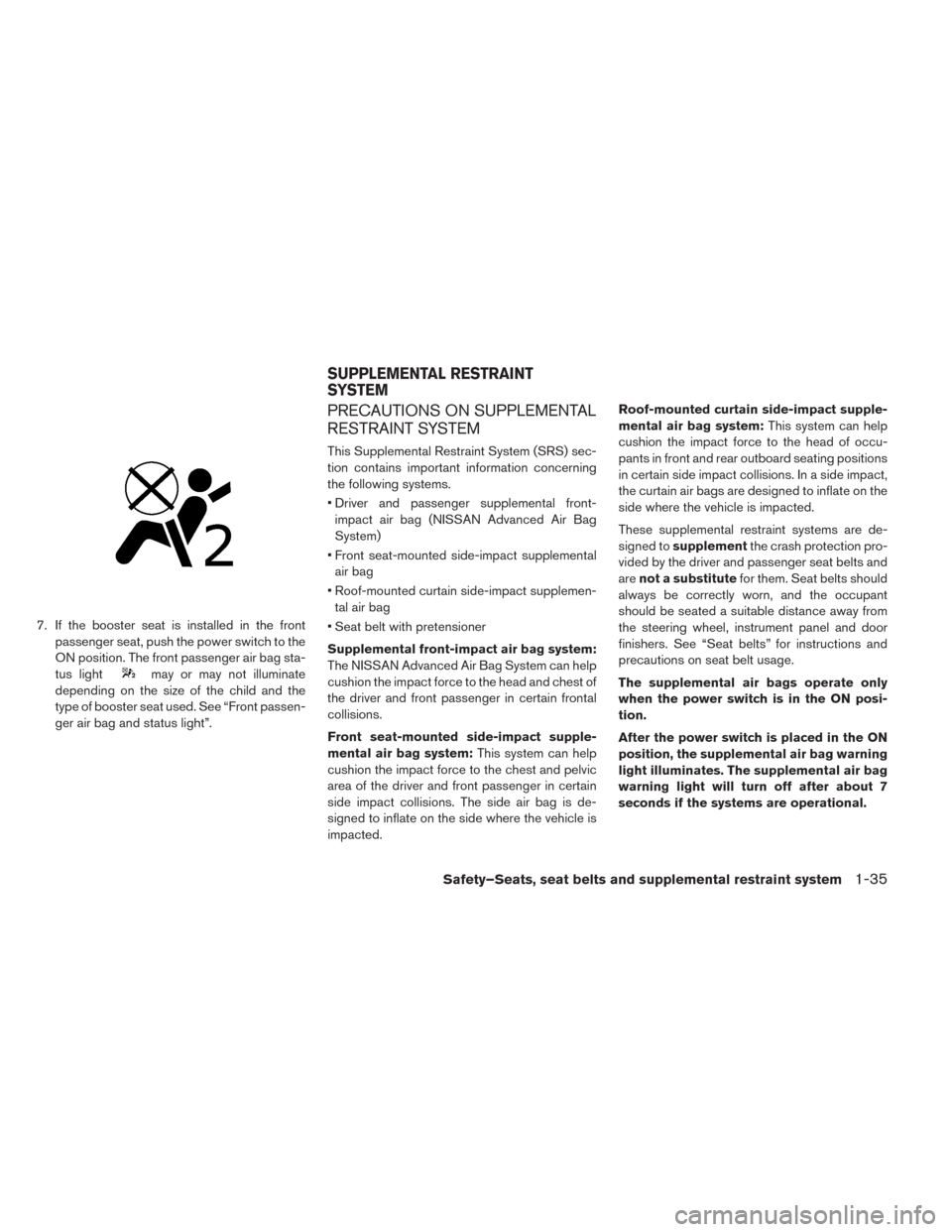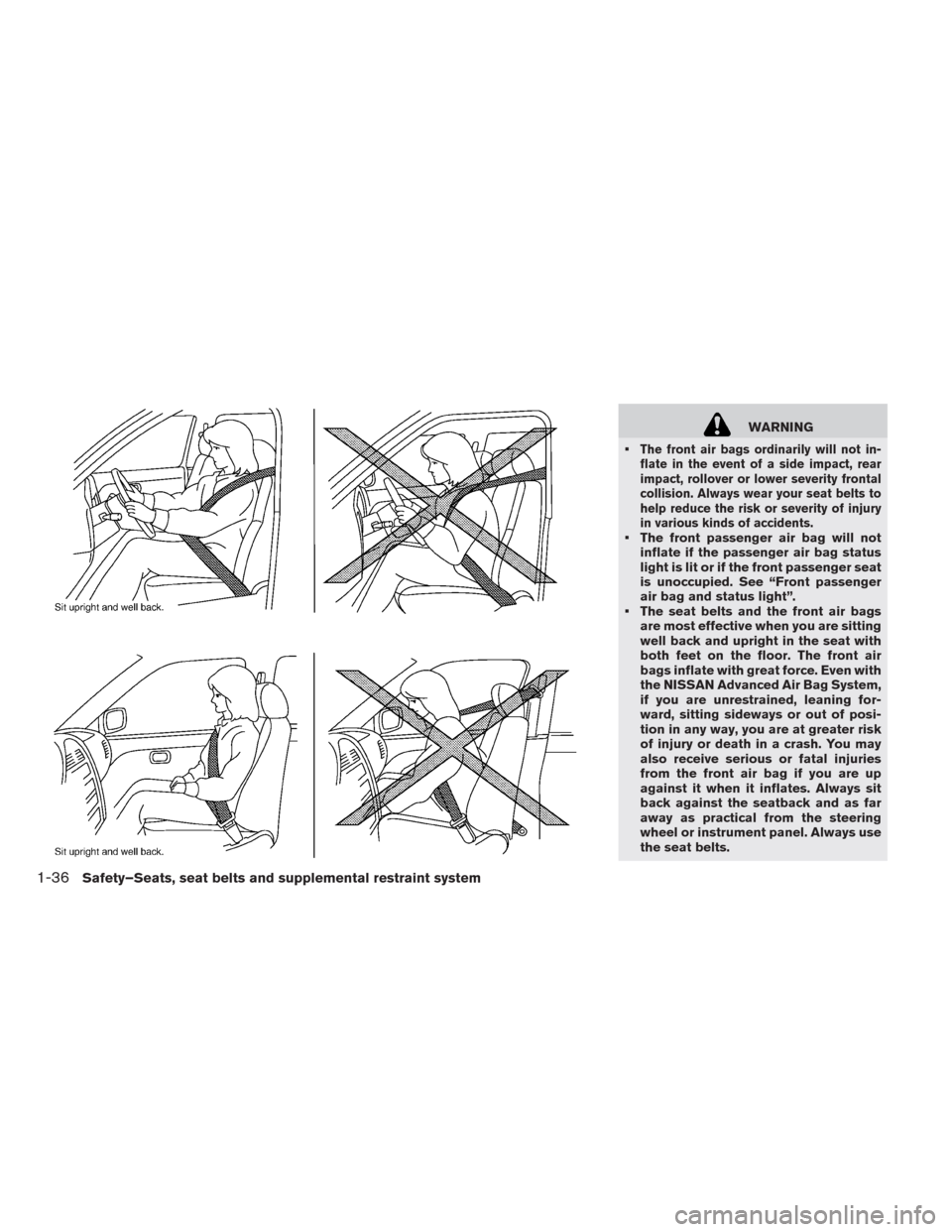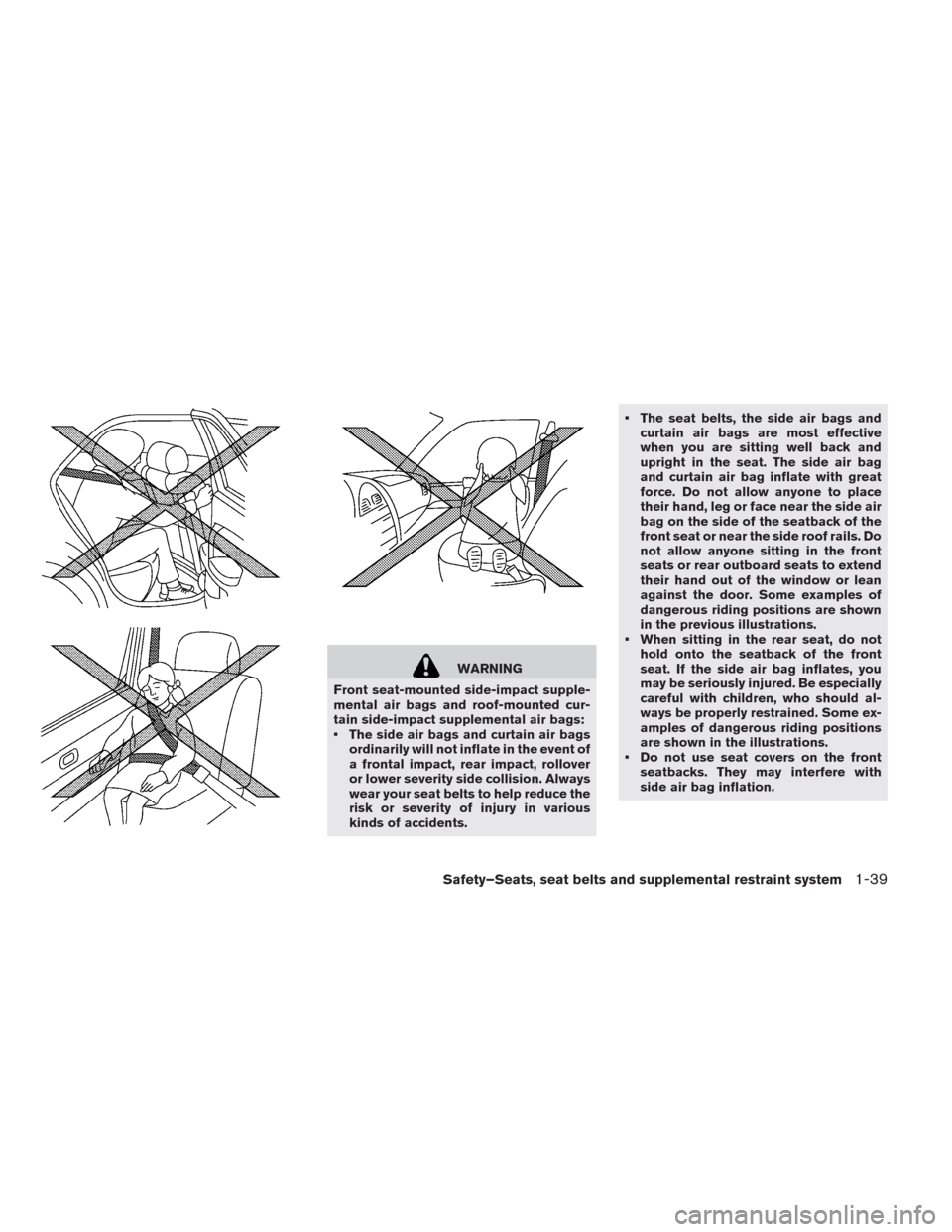Page 119 of 397

• Make sure the child’s head will be properly
supported by the booster seat or vehicle seat.
The seatback must be at or above the center of
the child’s ears. For example, if a low back
booster seat
�1is chosen, the vehicle seatback
must be at or above the center of the child’s
ears. If the seatback is lower than the center of
the child’s ears, a high back booster seat
�2
should be used.• If the booster seat is compatible with your ve-
hicle, place your child in the booster seat and
check the various adjustments to be sure the
booster seat is compatible with your child. Al-
ways follow all recommended procedures.
All U.S. states and Canadian provinces or
territories require that infants and small
children be restrained in an approved child
restraint at all times while the vehicle is
being operated.
The instructions in this section apply to booster
seat installation in the rear seats or the front
passenger seat.
BOOSTER SEAT INSTALLATION
CAUTION
Do not use the lap/shoulder belt Auto-
matic Locking Retractor (ALR) mode
when using a booster seat with the seat
belts.
Refer to all Warnings and Cautions in “Child
safety”, “Child restraints” and “Booster seats”
earlier in this section before installing a child
restraint.
Safety–Seats, seat belts and supplemental restraint system1-33
Page 120 of 397

Follow these steps to install a booster seat on the
rear seat or on the front passenger seat:
1.If you must install a booster seat in the
front seat, move the seat to the rearmost
position.
2. Position the booster seat on the seat. Only
place it in the forward-facing direction. Al-
ways follow the booster seat manufacturer’s
instructions.
3. The booster seat should be positioned on the
vehicle seat so that it is stable.If necessary, adjust or remove the head
restraint/headrest to obtain the correct
booster seat fit. If the head restraint/headrest
is removed, store it in a secure place.Be sure
to reinstall the head restraint/headrest
when the booster seat is removed.See
“Remove”, “Install” or “Adjust” under “Head
restraints/headrests” for head restraint/
headrest adjustment, removal and installation
information.If the seating position does not have an adjust-
able head restraint/headrest and it is interfer-
ing with the proper booster seat fit, try another
seating position or a different booster seat.
4. Position the lap portion of the seat belt low
and snug on the child’s hips. Be sure to follow
the booster seat manufacturer’s instructions
for adjusting the seat belt routing.
5. Pull the shoulder belt portion of the seat belt
toward the retractor to take up extra slack. Be
sure the shoulder belt is positioned across the
top, middle portion of the child’s shoulder. Be
sure to follow the booster seat manufacturer’s
instructions for adjusting the seat belt routing.
6. Follow the warnings, cautions and instruc-
tions for properly fastening a seat belt shown
in “Three-point type seat belt with retractor”.
Front passenger seatFront passenger seat
1-34Safety–Seats, seat belts and supplemental restraint system
Page 121 of 397

7. If the booster seat is installed in the front
passenger seat, push the power switch to the
ON position. The front passenger air bag sta-
tus light
may or may not illuminate
depending on the size of the child and the
type of booster seat used. See “Front passen-
ger air bag and status light”.
PRECAUTIONS ON SUPPLEMENTAL
RESTRAINT SYSTEM
This Supplemental Restraint System (SRS) sec-
tion contains important information concerning
the following systems.
• Driver and passenger supplemental front-
impact air bag (NISSAN Advanced Air Bag
System)
• Front seat-mounted side-impact supplemental
air bag
• Roof-mounted curtain side-impact supplemen-
tal air bag
• Seat belt with pretensioner
Supplemental front-impact air bag system:
The NISSAN Advanced Air Bag System can help
cushion the impact force to the head and chest of
the driver and front passenger in certain frontal
collisions.
Front seat-mounted side-impact supple-
mental air bag system:This system can help
cushion the impact force to the chest and pelvic
area of the driver and front passenger in certain
side impact collisions. The side air bag is de-
signed to inflate on the side where the vehicle is
impacted.Roof-mounted curtain side-impact supple-
mental air bag system:This system can help
cushion the impact force to the head of occu-
pants in front and rear outboard seating positions
in certain side impact collisions. In a side impact,
the curtain air bags are designed to inflate on the
side where the vehicle is impacted.
These supplemental restraint systems are de-
signed tosupplementthe crash protection pro-
vided by the driver and passenger seat belts and
arenot a substitutefor them. Seat belts should
always be correctly worn, and the occupant
should be seated a suitable distance away from
the steering wheel, instrument panel and door
finishers. See “Seat belts” for instructions and
precautions on seat belt usage.
The supplemental air bags operate only
when the power switch is in the ON posi-
tion.
After the power switch is placed in the ON
position, the supplemental air bag warning
light illuminates. The supplemental air bag
warning light will turn off after about 7
seconds if the systems are operational.
SUPPLEMENTAL RESTRAINT
SYSTEM
Safety–Seats, seat belts and supplemental restraint system1-35
Page 122 of 397

WARNING
•
The front air bags ordinarily will not in-
flate in the event of a side impact, rear
impact, rollover or lower severity frontal
collision. Always wear your seat belts to
help reduce the risk or severity of injury
in various kinds of accidents.
• The front passenger air bag will not
inflate if the passenger air bag status
light is lit or if the front passenger seat
is unoccupied. See “Front passenger
air bag and status light”.
• The seat belts and the front air bags
are most effective when you are sitting
well back and upright in the seat with
both feet on the floor. The front air
bags inflate with great force. Even with
the NISSAN Advanced Air Bag System,
if you are unrestrained, leaning for-
ward, sitting sideways or out of posi-
tion in any way, you are at greater risk
of injury or death in a crash. You may
also receive serious or fatal injuries
from the front air bag if you are up
against it when it inflates. Always sit
back against the seatback and as far
away as practical from the steering
wheel or instrument panel. Always use
the seat belts.
1-36Safety–Seats, seat belts and supplemental restraint system
Page 123 of 397
• The driver and front passenger seat
belt buckles are equipped with sen-
sors that detect if the seat belts are
fastened. The Advanced Air Bag Sys-
tem monitors the severity of a collision
and seat belt usage then inflates the
air bags as needed. Failure to properly
wear seat belts can increase the risk or
severity of injury in an accident.
• The front passenger seat is equipped
with occupant classification sensors
(weight sensors) that turn the front
passenger air bag OFF under some
conditions. This sensor is only used in
this seat. Failure to be properly seated
and wearing the seat belt can increase
the risk or severity of injury in an acci-
dent. See “Front passenger air bag
and status light”.
• Keep hands on the outside of the
steering wheel. Placing them inside
the steering wheel rim could increase
the risk that they are injured if the front
air bag inflates.
Safety–Seats, seat belts and supplemental restraint system1-37
Page 124 of 397
WARNING
• Never let children ride unrestrained or
extend their hands or face out of the
window. Do not attempt to hold them
in your lap or arms. Some examples of
dangerous riding positions are shown
in the illustrations.
• Children may be severely injured or
killed when the front air bags, side air
bags or curtain air bags inflate if they
are not properly restrained. Pre-teens
and children should be properly re-
strained in the rear seat, if possible.
• Even with the NISSAN Advanced Air
Bag System, never install a rear-facing
child restraint on the front seat. An
inflating front air bag could seriously
injure or kill your child. See “Child re-
straints” for details.
Do not lean against doors or windows.
1-38Safety–Seats, seat belts and supplemental restraint system
Page 125 of 397

WARNING
Front seat-mounted side-impact supple-
mental air bags and roof-mounted cur-
tain side-impact supplemental air bags:
• The side air bags and curtain air bags
ordinarily will not inflate in the event of
a frontal impact, rear impact, rollover
or lower severity side collision. Always
wear your seat belts to help reduce the
risk or severity of injury in various
kinds of accidents.• The seat belts, the side air bags and
curtain air bags are most effective
when you are sitting well back and
upright in the seat. The side air bag
and curtain air bag inflate with great
force. Do not allow anyone to place
their hand, leg or face near the side air
bag on the side of the seatback of the
front seat or near the side roof rails. Do
not allow anyone sitting in the front
seats or rear outboard seats to extend
their hand out of the window or lean
against the door. Some examples of
dangerous riding positions are shown
in the previous illustrations.
• When sitting in the rear seat, do not
hold onto the seatback of the front
seat. If the side air bag inflates, you
may be seriously injured. Be especially
careful with children, who should al-
ways be properly restrained. Some ex-
amples of dangerous riding positions
are shown in the illustrations.
• Do not use seat covers on the front
seatbacks. They may interfere with
side air bag inflation.
Safety–Seats, seat belts and supplemental restraint system1-39
Page 126 of 397
1. Crash zone sensor
2. Supplemental front-impact air bag modules
3. Front seat-mounted side-impact supplemen-
tal air bag modules4. Occupant classification sensors (weight
sensors)
5. Occupant classification system control unit
6. Roof-mounted curtain side-impact supple-
mental air bag inflators7. Roof-mounted curtain side-impact supple-
mental air bag modules
8. Satellite sensors
9. Lap outer pretensioner (driver side only)
10. Seat belt with pretensioner
11. Air bag Control Unit (ACU)
1-40Safety–Seats, seat belts and supplemental restraint system